To help inspire or plan your trip to Vietnam, some of its major attractions
for travellers are shown below, including some of the best natural, historical, cultural and adventure sites in the country.
These include all of UNESCO World Heritage Sites for Vietnam which represent the best
of the world's cultural and natural heritage.
Click on the icons below to focus on specific types of features
(click again to return to all).
|
|
|
|
|
|
|
|
|
|
|
|
 |
|---|---|---|---|---|---|---|---|---|---|---|---|
| Natural | History | Wildlife | Trekking | Cities | Religious Monument | Boat Journey | Rail Journey | Diving | Cultural | Adrenaline | UNESCO WHS |
UNESCO World Heritage Sites in Vietnam
| Halong Bay | |
|---|---|
Halong Bay, whose name means "descending dragon", is a stunning site, where 3,000 limestone karst islands and peaks rise out of the emerald green waters of the bay. The best way to appreciate this area is on a slow junk boat ride through the bay, stopping off to explore limestone caves filled with stalactites and stalagmites, encounter floating fishing villages, enjoy secluded beaches or just swimming in the bay itself. UNESCO World Heritage Site: Ha Long Bay | |
| Imperial Citadel of Thang Long | |
|---|---|
The Imperial Citadel of Thang Long is located on the Red River Delta in Hanoi. Built in the 11th century on the remains of a Chinese fortress, it marked the independence of the Dai Viet and was the regional centre of power of nine centuries, lying between the Chinese to the north and the Kingdom of Champa to the south. UNESCO World Heritage Site: Central Sector of the Imperial Citadel of Thang Long - Hanoi | |
| Hue | |
|---|---|
Hue was the imperial capital of Vietnam, and its religious and cultural centre, under the Nguyen dynasty from 1801 to 1945. The walled imperial citadel, containing the Forbidden Purple Palace (an exact replica of Beijing's Forbidden Palace), covers a vast area but much of it was destroyed during the Tet Offensive in 1968. The Ngo Mon Gate, some of the outer walls and the Flag Tower remain however, providing an eloquent glimpse at the glories of imperial Vietnam. The beautiful and evocative Perfume River runs through Hue and dragon boat rides along the river will take you to more of Hue's attractions. The Thien Mu Pagoda is the oldest monastery in Hue and one of the most beautiful buildings in Vietnam. There are also the tombs of the Nguyen emperors, such as that of Tu Duc, which provide insights into the lifestyles of the emperors. UNESCO World Heritage Site: Complex of Hué Monuments | |
| My Son | |
|---|---|
The Champa Kingdom developed on the coast of Vietnam between the 4th and 13th centuries. The kingdom displayed spiritual and architectural influences from Indian Hinduism. The ruins at My Son, the religious and political capital, comprise a series of impressive and well preserved tower temples located in a secluded valley. UNESCO World Heritage Site: My Son Sanctuary | |
| Hoi An | |
|---|---|
From the 15th to the 19th century, Hoi An was one of the most important trading ports in Vietnam, visited by ships from all over the world trading goods such as spices, silks and ceramics. When its harbour silted up in the 19th century it became eclipsed by Da Nang and other ports. Hoi An's economic loss was the world's gain, as the town preserved its old appearance and, as the only example of a traditional Vietnamese town, has become a major tourist destination. Hoi An is characterised by narrow streets and beautifully preserved buildings displaying indigenous and foreign influences, including the famous Japanese bridge. It's a beautiful town for wandering, tasting the fantastic local cuisine or exploring the surrounding countryside and nearby beaches. Hoi An is also famous for its myriad of clothes shops which will produce tailor made clothes from hundreds of materials and designs within hours at very low prices. UNESCO World Heritage Site: Hoi An Ancient Town | |
| Phong Nha-Ke Bang National Park | |
|---|---|
Phong Nha-Ke Bang National Park in Quang Binh Province comprises a very complex karst landscape, the oldest in Asia. It contains 65 kilometres of caves and underground rivers - Phong Nha Cave is almost 45 kilometres long and tour boats can travel over 1500 metres into the cave. On the surface the park is mostly covered by tropical forest and over 500 vertebrate species have been identified, including ten species of primates. UNESCO World Heritage Site: Phong Nha-Ke Bang National Park | |
| Citadel of the Ho Dynasty | |
|---|---|
The citadel of the 14th -century Ho Dynasty reflects the flowering of neo-Confucianism in Vietnam in this period. Designed by feng shui principles, it was built in a landscape of great scenic beauty on an axis joining the Tuong Son and Don Son mountains in a plain between the Ma and Buoi rivers. UNESCO World Heritage Site: Citadel of the Ho Dynasty | |
Other World Heritage Sites in Vietnam
 | Trang An Landscape Complex | Mixed site |
|---|






